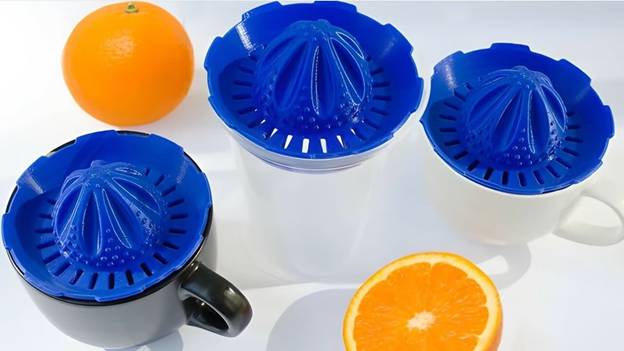When it comes to 3D printing with food-safe materials, no doubt… the options out there can be overwhelming!
Every 3D modeler and printer user wants a filament that’s both reliable enough for their desired application but also certified as 100% safe for food contact.
So what should you look for when trying to find a food-safe 3D printer filament?
In this blog post, we’ll take an in-depth look at some of the best food-safe filaments on the market – breaking down all their pros, cons, and essential features!
We will cover the below points in this article so that you can get each and every piece of information about Food-Safe 3D Printer Filament.
- What is a Food-Safe 3D Printer Filament?
- Different Types of food-safe 3D Printer Filaments Available
- Benefits of Using Food-Safe 3D Printer Filaments
- Essential Features to Look for When Choosing a food-safe 3D Printer Filament
What is a Food-Safe 3D Printer Filament?
Food-safe 3D printer filament. Image source: All3DP
Food-safe 3D printer filament is the type of material used in a 3D printer to create items that can be safely consumed or used with food products.
This type of filament has been designed to meet both FDA and EU standards for food safety, making it a great choice for anyone interested in creating edible items or items that will come into contact with food items in the future.
Food-safe filaments are available in a variety of types and materials, including PLA (polylactic acid), PETG (polyethylene terephthalate glycol-modified), Nylon, TPU (thermoplastic polyurethane), PVA (polyvinyl alcohol), ABS (acrylonitrile butadiene styrene) and PETT (Polyethylene terephthalate).
Each of these materials has its own unique characteristics which make it suitable for different applications.
Different Types of food-safe 3D Printer Filaments are Available
To ensure the safety of food products and components, it’s important to use a filament specifically designed for safe food contact.
The types of filaments available for use with 3D printers vary greatly, but all must meet FDA guidelines for food contact compliance before they can be used for printing with food products.
- PLA (Polylactic Acid) is one of the most popular materials used for 3D printing with food products, as it’s non-toxic and biodegradable. PLA also offers good strength and durability when printed correctly and comes in a wide range of colors for added aesthetic appeal.
Properties:
- Non-toxic and biodegradable
- Offers good strength and durability when printed correctly
- Comes in a wide range of colors for added aesthetic appeal
- Can be printed at lower temperatures compared to other filaments
- Has a low shrinkage rate which reduces warping
- Not suitable for high-temperature applications
- PETG (Polyethylene terephthalate glycol-modified) is another popular filament choice for food-safe 3D printing as it offers better heat resistance than PLA, making it suitable for hot foods or liquids like soups or sauces. It also has excellent clarity to show off an intricate design or a logo on your finished product.
Properties:
- Better heat resistance than PLA, making it suitable for hot foods or liquids like soups or sauces
- Excellent clarity to show off intricate designs or logos
- Durable and strong
- Resistant to impact and chemical damage
- Food-safe and recyclable
- Can be printed at relatively low temperatures compared to other filaments
- TPU (Thermoplastic polyurethane) is yet another option that combines flexibility with strength and toughness to create highly durable solutions that are ideal for those applications where you need extra protection from wear and tear while still maintaining food-safety standards.
It’s also easy to customize with different colors and finishes depending on your needs.
Properties:
- Combines flexibility with strength and toughness to create highly durable solutions
- Ideal for applications where extra protection from wear and tear is needed while still maintaining food-safety standards
- Can be printed at relatively low temperatures compared to other filaments
- Resistant to oil, grease, and abrasion
- Can be printed in different colors and finishes depending on needs
- Can be flexible or rigid depending on the desired outcome
Benefits of Using Food-Safe 3D Printer Filaments

A woman using food safe 3D printer filament. Image source: Sculpteo
Using food-safe 3D printer filaments can bring several benefits, including:
- Safety: One of the primary benefits of using food-safe 3D printer filaments is ensuring that the end product is safe for human consumption. Food-safe filaments are made from materials that are non-toxic and do not contain harmful chemicals, making them safe to use for printing food-related objects such as cutlery, kitchen utensils, or food molds.
- Customization: 3D printing allows for greater customization, which means that you can create unique and personalized designs for your food-related products. With food-safe filaments, you can easily print items that are tailored to your specific needs, whether it’s creating custom cookie cutters or unique serving dishes.
- Efficiency: 3D printing can be a much faster and more efficient process than traditional manufacturing methods. With 3D printing, you can quickly produce multiple copies of the same object, reducing the time and effort required for creating prototypes or mass production runs.
- Sustainability: Food-safe 3D printer filaments are often made from biodegradable materials, making them an eco-friendly choice for creating food-related objects. PLA, for example, is made from renewable resources such as cornstarch or sugar cane, which means that it can be composted after use.
- Cost-Effective: 3D printing can be a cost-effective option for creating small quantities of custom objects. Traditional manufacturing methods may require expensive molds or tooling, which can be prohibitively expensive for small-scale production runs. With 3D printing, you can produce small quantities of custom objects at a fraction of the cost.
- Design Flexibility: 3D printing allows for greater design flexibility, which means that you can easily create complex shapes and intricate designs that may be difficult to achieve with traditional manufacturing methods. This can be particularly useful when creating food molds or customized kitchen utensils.
- Waste: With 3D printing, there is less material waste compared to traditional manufacturing methods. The filament is only used to create the object, and any excess material can be recycled and reused for future printing projects.
Overall, using food-safe 3D printer filaments can offer a range of benefits, including safety, customization, efficiency, sustainability, cost-effectiveness, design flexibility, and reduced waste.
Essential Features to Look for When Choosing a food-safe 3D Printer Filament
- When selecting a food-safe 3D printer filament, it’s important to consider the following features:
- Safety and Quality – Look for filaments that are labeled as “food-safe” or “FDA-approved.” This will ensure that the material is safe for contact with food. Additionally, make sure that the filament has been tested and certified as free of toxins and other contaminants.
- Durability – When printing with food-safe filaments, it’s important to make sure they can stand up to repeated use and contact with water. Make sure that the filament you choose has good mechanical strength which will make your prints more durable.
- Cost – It’s important to keep in mind the cost when selecting a filament, as some filaments can be expensive due to their specialized nature. Consider both the cost per spool as well as any additional costs associated with maintenance or waste disposal of your prints.
- Compatibility – Finally, it’s essential to check that your 3D printer is compatible with the specific type of food-safe filament you’re interested in using. Some printers are designed for certain types of materials, so make sure you find one that is compatible with your chosen filament before purchasing it.
When deciding on the best software to use for 3D printing, SelfCAD offers the best experience of 3D printed objects. Thisonline slicer offers a range of tools and features for creating 3D models, including parametric modeling, sculpting, drawing, and rendering. It provides a browser-based interface, which means you can access and use the software directly in your web browser without the need for any downloads or installations. This feature makes it convenient for users who prefer cloud-based solutions or have limited computer resources.
Conclusion
Food-safe 3D printer filament is a great way to ensure that your prints are free of harmful chemicals and toxins.
There are many benefits to using food-safe filaments, including the peace of mind that comes with knowing your prints are safe to eat. When choosing a food-safe filament, be sure to look for one that is made from FDA-approved materials and that has been third-party tested for safety.
There are many different types of food-safe filaments available on the market, so you should be able to find one that meets your specific needs.







